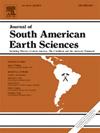The 40th anniversary of the Chilenia terrane: Where is its Grenville-age basement?
IF 1.7
4区 地球科学
Q3 GEOSCIENCES, MULTIDISCIPLINARY
引用次数: 0
Abstract
As is well known, the advent of plate tectonics in the early 1960s brought about a worldwide revolution in the Earth Sciences. In Argentina, a pioneer in applying plate tectonic thinking in the early 1980s was Dr. Víctor Ramos, who introduced provocative ideas about the presence of various terranes that formed Argentina and South America. Many of the proposed terranes were quickly adopted by the national and international geological community, although some crucial data were still lacking to be conclusive. One of these terranes, called Chilenia, corresponds to an alleged extensive continental block of near 1100 km long and 200 km wide, with a Grenville-age basement outcropping in the Cordón del Portillo, Frontal Cordillera of Mendoza province. This terrane is thought to have been accreted to the southwestern margin of Gondwana during the Late Devonian. Forty years after the birth of this idea, we revisit the existence (or not) of a Grenville-age basement within this terrane, integrating previous and new U-Pb zircon ages. New findings reveal no evidence of a Grenville-age basement, but instead indicate a Neoproterozoic or middle to upper Cambrian sedimentary succession overprinted by late Devonian metamorphism occur, i.e., the Guarguaráz Metamorphic Complex.
智利高地40周年纪念:格伦维尔时代的地下室在哪里?
众所周知,20世纪60年代初板块构造论的出现给地球科学带来了一场世界性的革命。在阿根廷,20世纪80年代早期应用板块构造思想的先驱是Víctor Ramos博士,他提出了关于形成阿根廷和南美洲的各种地体存在的具有煽动性的观点。许多提议的地形很快被国家和国际地质界采纳,尽管仍缺乏一些决定性的关键数据。其中一个被称为Chilenia的地块对应于一个据称长1100公里,宽200公里的广阔大陆块,在门多萨省正面科迪勒拉的Cordón del Portillo有一个grenville时代的基底露头。这个地体被认为是在晚泥盆世期间被吸积到冈瓦纳的西南边缘的。在这个想法诞生40年后,我们重新审视了格伦维尔时代基底的存在(或不存在),整合了以前和新的U-Pb锆石年龄。新发现没有发现格伦维尔时代基底的证据,而是表明发生了由晚泥盆世变质作用覆盖的新元古代或中上寒武统沉积序列,即Guarguaráz变质杂岩。
本文章由计算机程序翻译,如有差异,请以英文原文为准。
求助全文
约1分钟内获得全文
求助全文
来源期刊

Journal of South American Earth Sciences
地学-地球科学综合
CiteScore
3.70
自引率
22.20%
发文量
364
审稿时长
6-12 weeks
期刊介绍:
Papers must have a regional appeal and should present work of more than local significance. Research papers dealing with the regional geology of South American cratons and mobile belts, within the following research fields:
-Economic geology, metallogenesis and hydrocarbon genesis and reservoirs.
-Geophysics, geochemistry, volcanology, igneous and metamorphic petrology.
-Tectonics, neo- and seismotectonics and geodynamic modeling.
-Geomorphology, geological hazards, environmental geology, climate change in America and Antarctica, and soil research.
-Stratigraphy, sedimentology, structure and basin evolution.
-Paleontology, paleoecology, paleoclimatology and Quaternary geology.
New developments in already established regional projects and new initiatives dealing with the geology of the continent will be summarized and presented on a regular basis. Short notes, discussions, book reviews and conference and workshop reports will also be included when relevant.
 求助内容:
求助内容: 应助结果提醒方式:
应助结果提醒方式:


